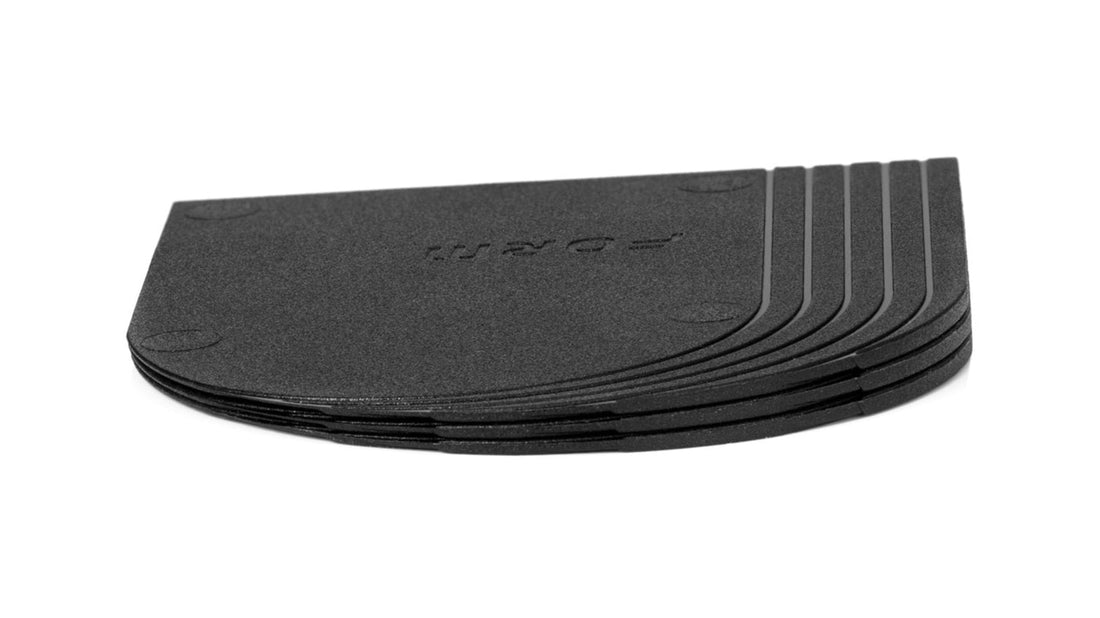
Wedges in bike fitting: Small angles, big impact
Nils KehrbergFoot position on the bike plays a key role in power transmission, joint stress, and long-term comfort. Even the smallest deviations in the alignment of the foot or leg axis can cause discomfort, for example, in the knee, hip, or lower and upper back.
An effective tool to solve these problems are wedges. They are inserted under the foot or under the cleat and, by making small angle changes, ensure better alignment of the leg axis while pedaling.
There are different types of wedges and we show when we use which wedges in bike fitting and how they can help to ensure more symmetry, less pain and more performance on the bike.
What wedges are available in bike fitting?
1. Forefoot wedges in the shoe
Forefoot wedges are placed inside the shoe under the ball of the foot, either directly under the insole or as an integral part of orthopedic insoles.
Goal:
To better align the foot in the event of lateral deviation (e.g. strong supination or pronation in the forefoot) and thereby reduce the strain on the knee and hip.
Especially suitable for riders with unstable foot position or one-sided knee pain.
2. Heel wedges in the shoe
Heel wedges are located in the back of the sole, under the heel, either integrated into special insoles or as separate wedges.
Goal:
Heel wedges can easily correct the rearfoot axis and create a stable foundation for the entire leg. Especially in cases of knock knees or bowlegs, overpronation, or severe heel misalignment, heel wedges can significantly improve the foot's gait.
Important for riders with visible deviations in the rear foot or asymmetrical knee movement.
3. Cleat wedges (wedges under the pedal cleat system)
Cleat wedges are mounted on the outside of the shoe, directly between the cleat and the sole. They change the angle of the entire foot to the pedal axis.
Goal:
A permanently stable foot position, especially when knees rotate strongly inward or outward during kicking. By tilting the foot in a targeted manner, the leg axis can be optimized and the strain on the knee reduced.
Typical use for riders with one-sided knee pain, uneven pressure distribution or visibly wandering knee during pedaling.
How does the use of wedges work in bike fitting?
During bike fitting, we first analyze the movement patterns, foot position and joint axis in detail, both visually and with the help of laser measurements and video analysis.
The most important steps:
- Analysis of foot shape: e.g., supination/pronation, deviation in the hindfoot or forefoot
- Measuring the feet in length and width
- Gait analysis and knee position
- Assessment of knee movement during pedaling (inward / outward rotating)
- Recording of complaints (e.g. knee, foot, hip pain on one side)
- Fine-tuning in combination with cleat position and insole system
Important: Wedges are not considered in isolation, but always in the context of the overall setup. Saddle height, Q-factor, and the athlete's mobility all influence the decision whether to use wedges.
When can wedges be useful?
- For one-sided pain in the knee or foot
- If the step feels unstable or wobbly
- If there is visible asymmetry of the knee axis during movement
- For relief in cases of structural peculiarities such as O-/X-legs
- As a supplement to individual insoles for specific foot positions
Difference between wedges in the shoe and under the cleat
| feature | Wedges in the shoe | Cleat wedges |
|---|---|---|
| Location | Inside the shoe (under the insole) | Outside between cleat and shoe |
| Effect | Influence on foot position, rearfoot/forefoot | Influence on the entire leg axis during kicking |
| flexibility | Can be used in combination with orthopedic insoles or separately | Easy to assemble, quickly adjustable |
| Typical application |
Foot misalignments, insole optimization, knee axis correction, stability, saddle problems |
Knee axis correction, asymmetric movement, saddle problems |
Conclusion: Small angles, big impact
Wedges are a key tool in our bike fittings to relieve discomfort, avoid incorrect loading, and improve movement economy.
Whether forefoot wedges, heel wedges or cleat wedges, all variants can help to support the natural axis between the foot, knee and hip, make the step more efficient and avoid long-term overload.
📄 Scientifically based
Brightwell, B.D., et al. (2022).
Blood flow restriction training after patellar INSTability (BRAINS Trial).
Trials, 23(1), 88.
About the study
Boon, K.Y. & Bonanno, D.R. (2014).
The effect of foot orthoses and in-shoe wedges during cycling: A systematic review.
Journal of Foot and Ankle Research, 7(1), 31.
About the study
